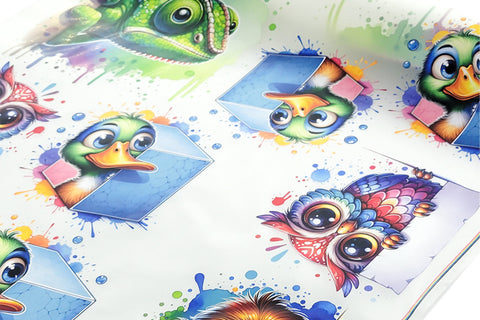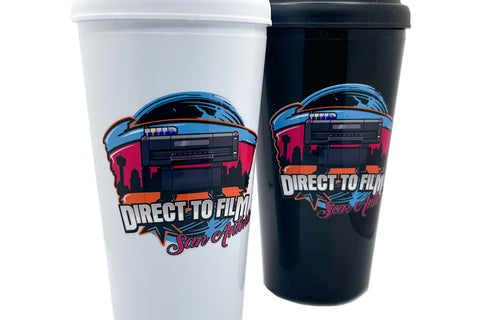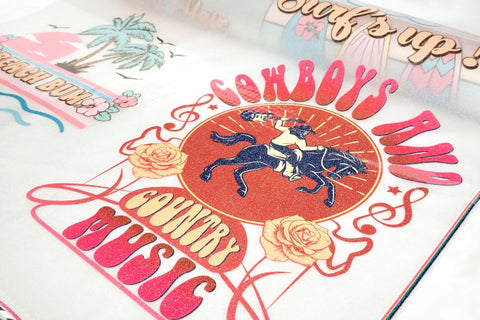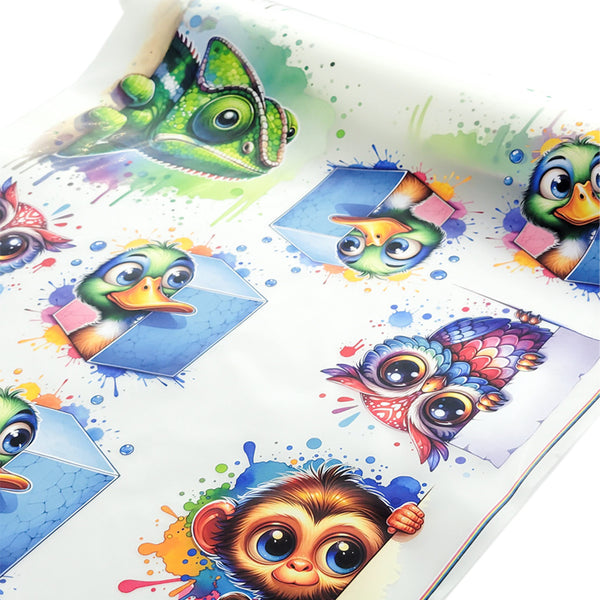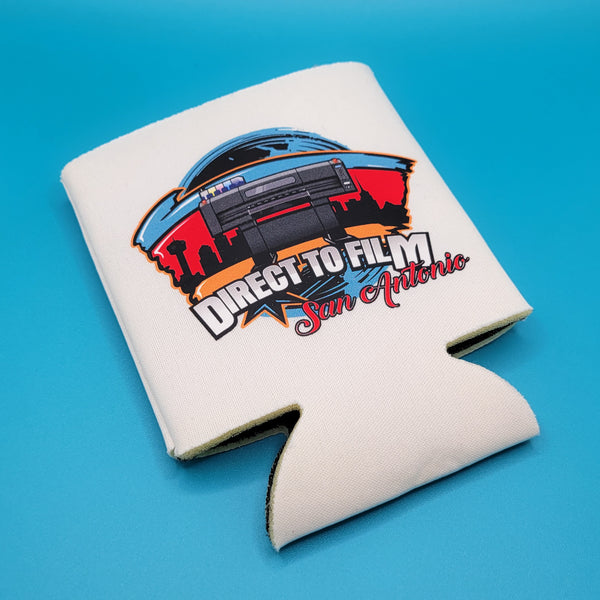Are you searching for the best custom printing method for your business or creative projects? Wondering whether DTF printing or UV DTF printing is the better choice for your needs?
To solve your confusion between DTF vs UV DTF, we will compare both options so that you can make a worthy decision.
What is DTF Printing?
Direct-to-film printing is a popular method used in textile printing to get customized prints on apparel easily. This printing technique is versatile because it works on multiple fabric types and provides a wide range of designs with full vibrancy.
The DTF printing method is quite simple, as you just have to make a design and load the PET film into the printer and adjust the required inks, and print the design on the film. Next, you apply a hot melt adhesive powder to the printed film and cure it using a heat press to set the adhesive properly.
To transfer the design, you place the film face down onto the fabric and press it firmly with a heat press to bond the ink and adhesive to the material. Once the fabric cools down, you simply peel off the film to reveal a vibrant, durable print that looks professional and long-lasting.
Characteristics of DTF Printing
-
This printing technique is suitable for textile and apparel printing.
-
It works well on a wide range of fabrics, including cotton, polyester, blends, etc.
-
You will get the flexible, soft, and durable prints that withstand multiple washes.
-
DTF printing does not require pre-treatment of garments like other printing methods.
Pros
-
Vibrant colors with great opacity
-
Lasts 30+ washes if done properly,
-
DTF transfers don’t require cutting excess material.
-
White ink base allows printing on any color.
Cons
-
Long process due to curing
-
DTF uses adhesive powder, which can be messy.
-
High initial cost due to buying a DTF printer, inks, and a heat press.
Further you can check the pros and cons of DTF printing in our detailed guide.
What is UV DTF Printing?
UV Direct to film method is an innovation in printing technology that combines ultraviolet (UV) printing with a special direct-to-film transfer process. Small business owners, Etsy sellers, and creators who personalize hard, non-porous items can go for this technique, and even for corporate branding, UV DTF works well. See the benefits.
The process involves a design that is directly printed onto a special adhesive film using a UV printer and UV-curable inks. As the printer lays down the colors, powerful UV lights instantly cure or harden the ink to create a vibrant and durable image on the film. Once printed, you apply a transfer film over the design and lift it from the back.
Characteristics of UV DTF Printing
-
UV DTF is perfect for hard, non-porous surfaces like glass, wood, metal, ceramics, plastic, and more.
-
It creates raised, textured prints with a glossy or matte finish.
-
They are highly durable, scratch-resistant, waterproof, and UV-resistant.
-
There is no need to use a heat press because transfer is done via pressure.
-
Get HD printing with incredible detail and vivid colors.
Pros
-
UV ink dries instantly under UV light
-
Sharper prints with a glossy effect
-
More durable than traditional DTF
-
Eliminates the need for adhesive powder
-
Instant drying speeds up the workflow
Cons
-
Can be stiffer than traditional DTF on fabrics.
-
Preferable for only hard surfaces, not fabrics
-
UV inks and printers are more expensive than DTF ones.
DTF vs UV DTF Printing- Quick Comparison
|
Aspect |
DTF Printing |
UV DTF Printing |
|
Materials |
Fabrics (cotton, polyester, blends) |
Hard surfaces (glass, wood, plastic, metal) |
|
Printing Ink |
Water-based pigment ink |
UV-curable ink |
|
Curing Process |
Heat press |
UV light exposure |
|
Transfer Method |
Heat transfer |
Pressure transfer (peel and stick) |
|
Finish |
Soft, flexible, fabric feel |
Glossy or matte raised texture |
|
Durability |
Wash-resistant |
Scratch, water, and UV resistant |
|
Typical Uses |
T-shirts, hoodies, bags |
Tumblers, phone cases, signs, mugs |
Which One Should You Choose?
Why you should choose the DTF printing method is a highly searchable query, and we suggest you choose DTF transfers when you are about to customize clothes, tote bags, or any fabric-based items. It is affordable, versatile, and perfect for textile applications.
You can go for UV DTF printing if you are customizing hard goods like tumblers, phone cases, glassware, wooden plaques, or metal signs. It is perfect for corporate branding, event promotions, and custom gift makers who need fast, high-resolution results without the need for large print runs.
Many businesses use both technologies, depending on their product line. For example, a printing shop might use DTF for custom T-shirts and UV DTF for personalized mugs and awards.
Get Premier DTF and UV DTF Printing with DTFSATX in San Antonio
If you are living in San Antonio, TX, and looking for DTF or UV DTF transfers, choose Dtfsatx.com! We provide a comprehensive range of services, including custom heat and UV DTF transfers. We serve hobbyists, entrepreneurs, and businesses alike.
Our user-friendly Gang Sheet Builder simplifies the design process, and customers can upload and arrange their artwork effortlessly. DTFSATX ensures vibrant, full-color prints that adhere to various surfaces, from fabrics to hard goods.
Final Thoughts
You can choose both DTF and UV DTF printing technologies according to your requirements. Both serve different purposes, and choosing the right method provides professional, long-lasting results. I hope this guide helped you in making an informed decision on which printing technology suits your business needs.
